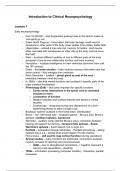Introduction to Clinical Neuropsychology
Lecture 1
Early neuropsychology
- from 10 000 BC – skull trepanation (poking holes in the skull to make he
‘evil spirits go out’
- Edwin Smith Papyrus – observation that brain damage could result in
symptoms in other parts of the body (case studies from military battle field)
- Hippocrates – noticed a man who lost ‘memory for letters’, skull trauma
often coincided with hemiparesis on other side of the body (cannot move
that half)
- Plato – localized different qualities of soul in different parts of the body
(proposal of one-to-one relationship function and brain location)
- Herophilus – localized intelligence in brain ventricles (dominant view until
the 18th century)
- Galen – first lesion studies – brain receives sensory information and has
motor control – fluid energies from ventricles
- Rene Descartes – dualism – pineal gland as seat of the soul –
interaction between mind and body
- In 1800s – idea that mental functions are localized in specific parts of the
brain (cerebral localization)
- Phrenology (Gall) – skull parts important for specific functions
o Cortex sends instructions to the spinal cord to command
muscles to move
o Localization of function
o Relation between skull surface features and person’s mental
faculties
o Cranioscopy – measuring bumps and depressions of a skull –
determining fitness to attend uni/get a job
- Bouillaud -speech localized in the frontal lobes, lateralization
- Broca – ‘tan’, left frontal lobe – localized speech – Broca’s area, Broca’s
aphasia, nonfluent aphasia, expressive
- Wernicke – auditory cortex (behind Broca’s area), connection between
hearing and speech functioning – temporal lobe aphasia – fluent,
Wernicke’s aphasia – fluent speech, but no logic to it
- Penfield – localization through electrodes – Penfield procedures – taking
epileptic focus out – seeing what would happen if it was inactive,
Homunculus – still used to map cortical function (during operations)
- Animal studies – many functions are distributed, connections between
neurons as basis for learning (and consciousness)
o Hebb – new or strengthened connections -> together represent a
memory (cell assemblies) – plasticity
- 1950s – information processing (computer models) – interactive, parallel
processes
, - 1980s – neuroimaging – connectionism (distributed function) – lower level
localized (sensory, motor), higher level (memory, language) – result of
interconnections between brain aeas
Neuropsychological assessment – measure brain and cognition
Neuroimaging – relation symptoms and brain pathology, diagnostics
Neuroanatomy
- The higher the level, the higher the function -> lower levels mediate
function
- Forebrain – neocortex, basal ganglia, limbic system, olfactory bulb, lateral
ventricles
- Brainstem (midbrain and hindbrain, diencephalon) – thalamus,
hypothalamus, pineal body, third ventricle, tectum, tegmentum, cerebral
aqueduct, cerebellum, pons, fourth ventricle, medulla oblongata
- Spinal cord
o Reflexes in limbs and torso – extension and flexion -> different
sensory fibers mediate different reflexes – also rhythmic walking
movements
o Segments correspond to regions of the body – dermatomes:
cervical nerves, thoracic nerves, lumbar nerves, sacral nerves
o Entering posterior root – bring sensory information from sensory
receptors
o Leaving anterior root – carry motor information to the muscles
o Collateral branches of sensory neurons – may cross to the other
side
o White-matter fiber tracts – carry information to and from the brain
Hindbrain
- Cerebellum – motor coordination, motor learning – posture, postural
reflexes, balance, skilled motor activity
- Reticular formation – ascending system – arousal, activating system
- Medulla – vital functions (breathing, cardiovascular)
- Pons (bridges input to and from the forebrain
Forebrain
Limbic system
- Self-regulatory behaviors – incl. emotion, emotional episodic memory,
spatial behavior, social behavior
- It is a circuit, not just a lobe – connected to cortical regions
- Hippocampus, amygdala, thalamus, hypothalamus, cingulate gyrus, fornix,
hypothalamus
- Amygdala – emotion
- Hippocampus – personal memory
- Cingulate cortex – sexual behavior
, Basal ganglia
- Structural components – caudate nucleus, putamen, globus pallidus
- Also substantia niagra
- Functions related to movement and learning
o Control and intensity of voluntary movement
o Integrating simple movements into patterns
o Simple learning processes (associative learning)
- Huntington’s – progressive dysfunction and death of cells of the basal
ganglia – hyperkinetic syndrome (excessive movement), hyperactive DA
system
o Movement symptoms – excessive, involuntary
o Cognitive – attention, memory, executive function, dementia
o Mood and personality – personality changes, paranoia, psychosis,
depression, mania
Cortex
- Ridges – gyri
- Clefts – sulci
Crossed brain
- Each hemisphere typically receives input and sends output to the
contralateral side of the body
- Visual system – combined in one eye
Conduction aphasia – sounds and movement are retained, speech is impaired
because it cannot be conducted from one region to the other
- Connection of regions important
- Alexia – loss of ability to read
- Apraxia – inability to make sequences of movements
- Binding problem – philosophical question, how the brain ties single and
varied sensory and motor events together into a unified perception of
behavior
- Visual form agnosia – not recognizing shapes of objects – ventral stream
– conscious visual perception
- Ataxia – problems with reaching for objects (guiding actions) – dorsal
stream – unconscious visual processes
Support and protection
- CNS lies within bony encasements, SNS and ANS – lie outside them
- CNS surrounded by meninges – dura mater, arachnoid membrane, pia
mater
- CSF – protects brain and spinal cord
- Blood brain barrier – protects brain and spinal cord, limits movement of
chemical from the rest of the body into the CNS, protects from toxic
substances and infection
,




